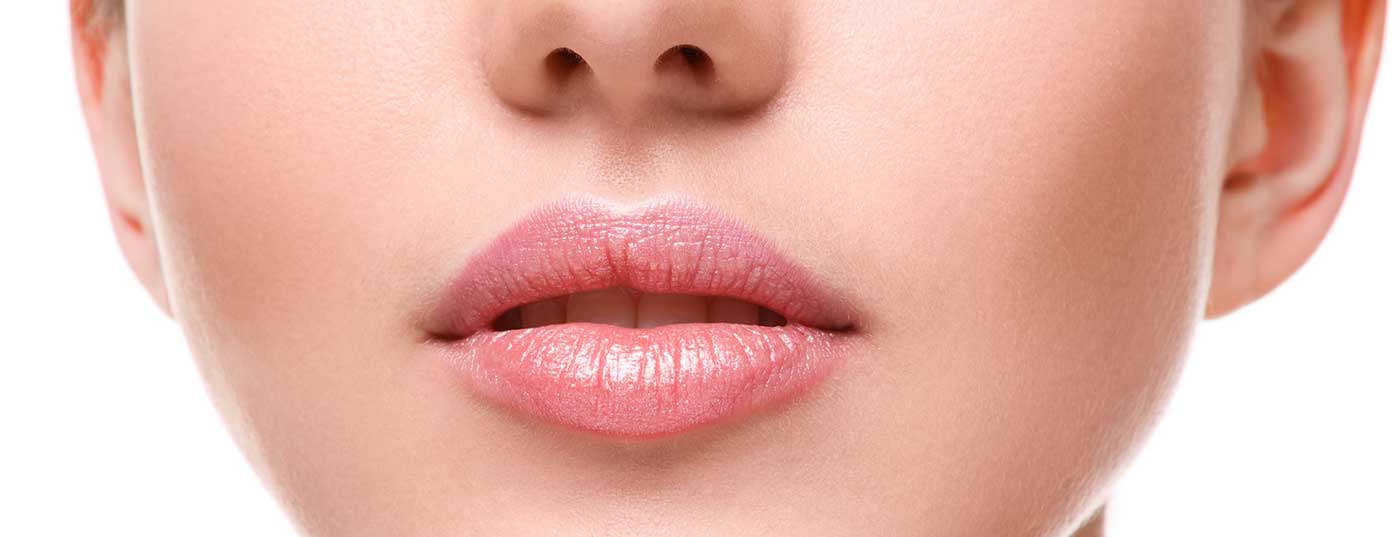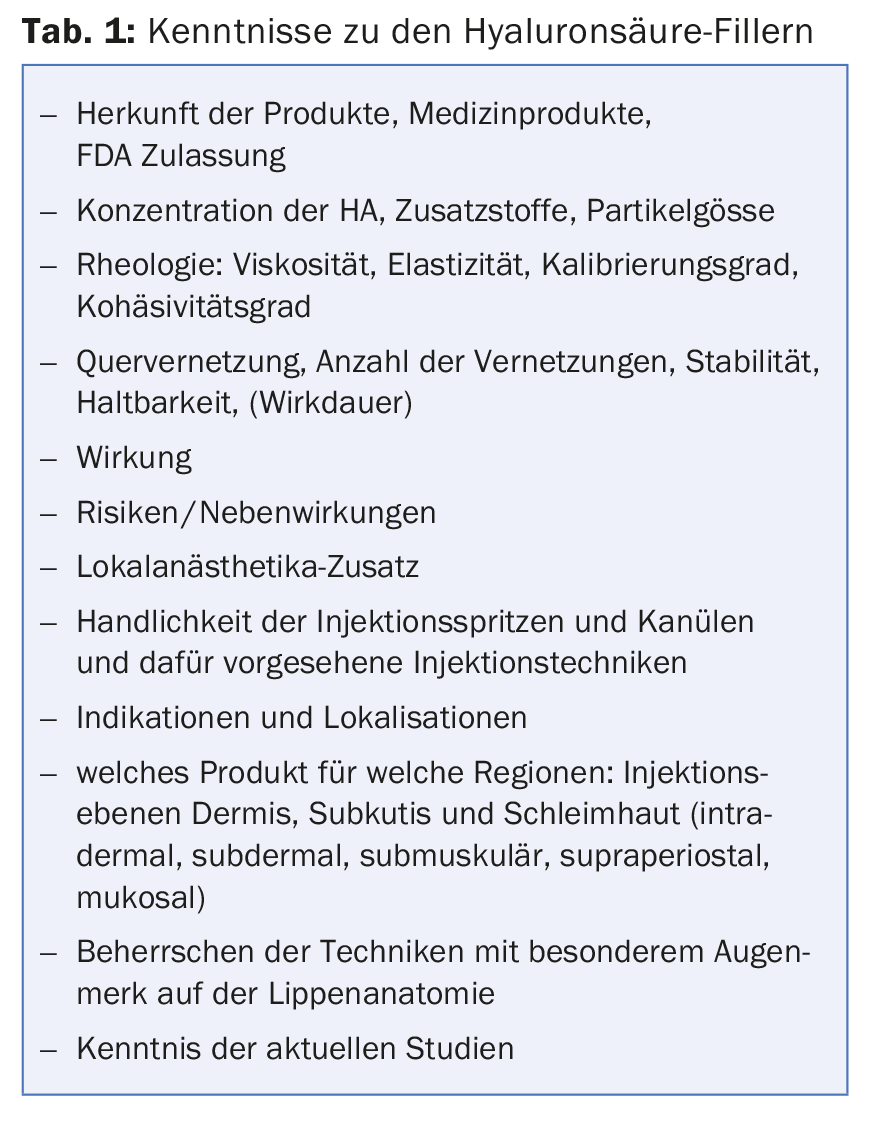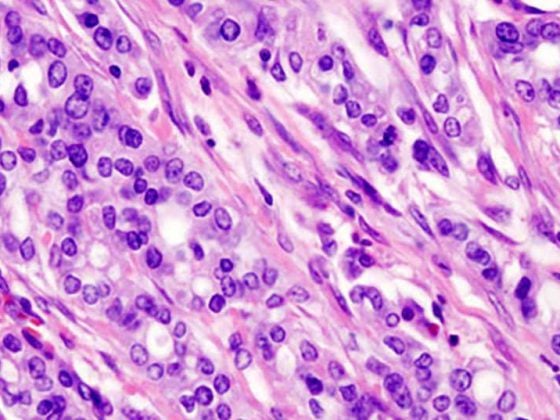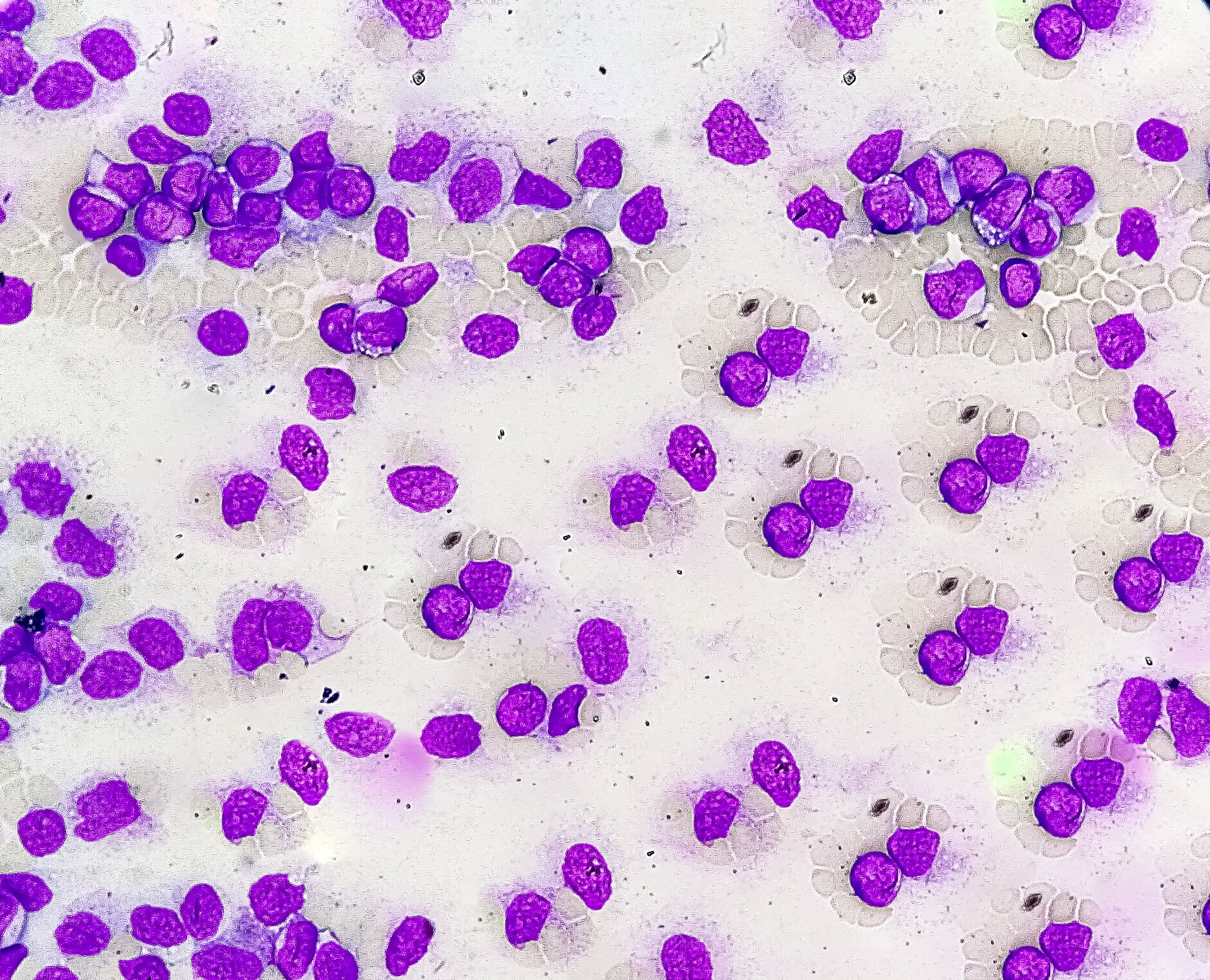Age-related lip changes present a challenge with the aesthetic deficits of the lower half of the face in the daily practice of aesthetic dermatology. Changes in shape, loss of contour and volume with wrinkling are the predominant characteristics of aging of the lips and lip area. Lips are associated with female, but also male sexuality. Natural beautiful lips are considered one of the attributes of attractiveness. The claim is not to look “sprayed” after treatment. A variety of products and injection options are available for lip beautification and surrounding region. Hyaluronic acid (HA) fillers are the gold standard for the lip and around the mouth. Proper HA product selection and knowledge of rheologies and clinical characteristics are critical to achieving the best possible outcomes and high patient satisfaction.
The lip is not to be judged alone. The treatment result can only become perfect in conjunction with the bony structures, fat compartments, ligaments, superficial musculoaponeurotic system (SMAS) and surrounding muscles of the entire face.
Architecture and anatomy of the lips
Understanding the anatomy, histological and functional structure of the lips with the perioral environment, as well as the physiological age-related changes of these regions and zones of the face is a prerequisite of treatment.
The major structures of the lip include the labial red, cupoid’s bow, lip margin, medial and lateral upper lip and lower lip tuberosity, philtrum, columella, oral commissure, and perioral white lip region (Fig. 1).
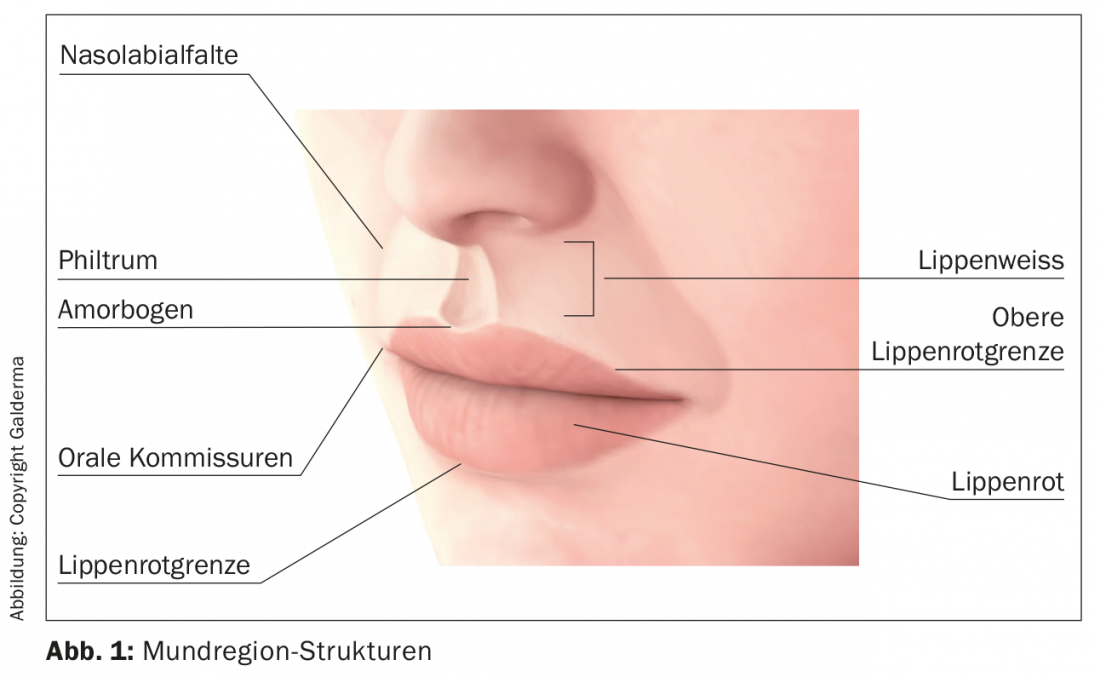
Histologically, three parts are distinguished: pars cutanea, pars intermedia and pars mucosa. The arterial supply goes through the branches of the facial artery, the superior labial artery and inferior labial artery. Venous outflow is via many small veins into the facial vein. The course of the superior and inferior labial arteries is subject to high variation. Three different positional variants have been described by S. Cotofana: Submucosal (between the oral mucosa and the orbicularis oris muscle [MOO]), intramuscular (between the two layers of the MOO) and subcutaneous (between the cutis and the MOO). Their course on the mucosal side near the lip margin between the muscle and glandular layers often varies in depth and is individually curvilinear. Motor innervation is provided by the facial nerve – sensory innervation is provided by the maxillary nerve for the upper lip, the mandibular nerve for the lower lip, and the branches of the trigeminal nerve.
Beauty code
The upper lip should be 18-20 mm from the nose and the lower lip 36-40 mm from the chin. The line in straight head position from the center of the nose opening to the tip of the chin (touching upper and lower lip) is called Steiner’s line. The profile of the upper lip should be located 1-2 mm in front of the lower lip in the projection. The nasolabial angle should be 85-105°. A slight elevation or protrusion at the inflection point where the lip joins the mucosa is called the Glogau-Klein point (G-K point). The ideal lip proportion is calculated by the phi proportion according to the code of beauty (golden ratio). It shifts with the aging of the lip. Phi proportions for the European woman are 1 for the upper lip and 1.618 for the lower lip (Asian and American vertical lip ratios are 1:1) [1,2].
The aging lip
With age, the red of the lips thins out and the upper lip becomes flat. The lower lip becomes longer and sinks. The red of the lips looks dehydrated and wilted. The columns flatten, the lip margin appears empty and thinned out, and the lateral lip red gradually collapses. Inversion of the lip red and curling of the lip margin with vertical lip red wrinkles and vertical upper lip wrinkles occur (Fig. 2A and B) . A convex triangle forms on each side of the white upper lip, forming a shadow. Commissures and puppet lines are strengthening. The midface shifts downward due to reduction of fat compartments. This downward trend (“sagging”) makes the cheekbones appear projectionless. Negative side effects include a nasolabial fold that appears visually deeper, as well as marionette lines with lower corners of the mouth and sagging cheeks (Fig. 2C). Genetically determined narrow lips can also already exist in younger people.
The degree of ptosis of the SMAS, the slackening of the ligaments, the reduction of the fat compartments, and also the depressor function of the depressor anguli oris (DAO) muscle and the platysma cannot be disregarded when planning injections. Several useful scales with grading of wrinkles and volume loss are available for treatment planning.
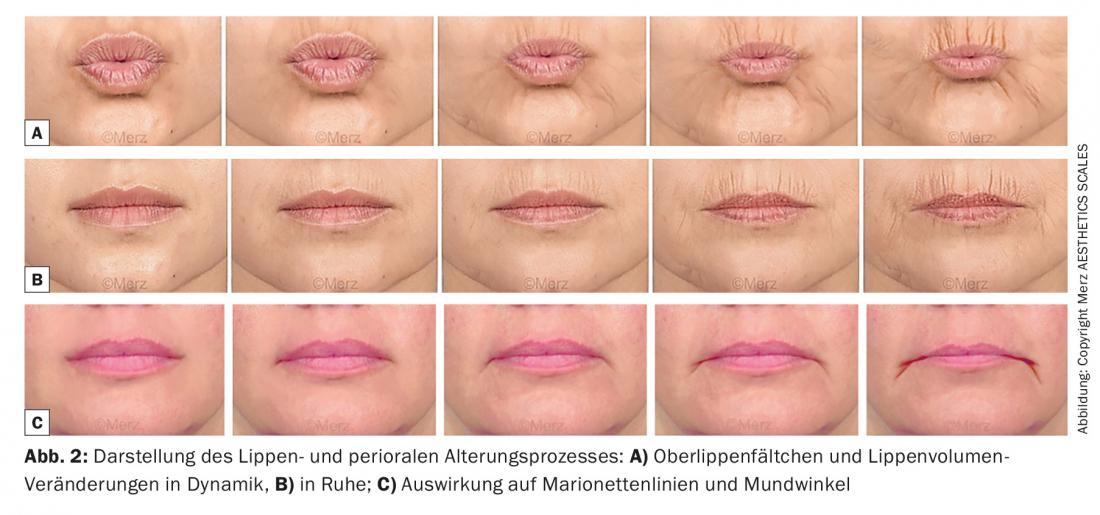
Requirements for HA in the treatment of the lip and perioral region.
A prerequisite for the optimal use of the 18 different lip injection techniques known worldwide is an up-to-date knowledge of HA filler development on the European market. FDA product approvals and off-label uses of botulinum toxin A (BTX-A) in the lip and surrounding region should be known.
The HAs are crosslinked and chemically modified to improve mechanical properties and durability. Synthetic crosslinking is carried out using various process methods and usually with BDDE (1,4-butanediol-diglycidyl ether). Many cross-linked and poorly interconnected HA disaccharides are common. The degree of this cross-linking has an influence on the stability. Stability is also achieved with a low number of chemical crosslinks and a high number of HA compounds among each other. The degree of modification defines the ratio of cross-linked molecules to HA disaccharide molecules. The strength of the gel always depends on the total number of crosslinked and uncrosslinked molecules. The stronger the gel, the higher the lifting capacity. To obtain good HA molecule biocompatibility, the modification must preferably be kept low. The degree of filler modification ranges from %–10% [3,4].
Most HA used for lip treatment have an intermediate gel texture between firm and soft. For the lips and surrounding wrinkles, we want a HA with a low capacity of swelling, in a soft gel form, but in a hardness adapted to the conditions of the MOO, dynamic wrinkles and adjacent muscles.
The rheological HA gel developments focus on
- an adaptability to the texture of the fabric
- a stable HA concentration
- a variable degree of cross-linking (cross-link)
- a variable calibration
- little injection resistance.
Significance of the rheological parameters
The storage modulus G’, which represents the elastic, solids-related portion of the filler, goes hand in hand with the volumetric effect. The higher the G’, the firmer and thus more volumetric the gel. The loss modulus or viscous modulus “G”, which represents the viscous, fluid portion of the filler, is associated with the flowability (i.e., the energy converted to heat by internal friction). The higher the “G”, the more viscous and flow-resistant the gel. Another parameter, tan δ, gives the ratio G”/G’. The higher the tan, the better the distribution of the gel in the tissue due to the stronger influence of the G”. The degree of swelling depends on the hardness of the HA gel, its cohesiveness (behavior of the filler once implanted as a gel depot) and the HA concentration [3–8]. Injection depths are made dependent on the degree of cross-linking and calibration.
The most important rheological gel property for the lips is the viscoelasticity of a filler. This property can be represented in the ratio of viscosity (G”) to elasticity (G’). A low G”/G’ ratio means a firmer, more solid gel. A higher ratio corresponds to a softer, more fluid gel [4,5]. The complex modulus describes the deformation resistance of an HA gel, represented by G*, and is the vector sum of the viscous modulus (G”) and elastic modulus (G’).
Fillers with low cohesivity and low or medium G* and G’ are well suited for superficial lip wrinkles in the perioral area and for lip volume. Dermal and subdermal injection is possible without irregular visible changes.
For marionette lines, the filler must be injected into the deep dermis or subdermally. Good integration, little projection, high shear force and compression force must be ensured. Thus, the ideal filler must have moderate G’ and low or moderate cohesivity. In this way, the filler can be modeled well. For chin projection, a filler with a high cohesivity and a high G’ is required, as stronger shear forces, increased muscle tension and more pressure due to the bone structure make high demands here [5,9,10].
Technologies in the development of HA
NASHA® and Optimal Balance Technology (OBT) (Galderma): Restylane® products contain stabilized non-animal hyaluron gel. The production is carried out with the help of the patent-protected NASHA® technology. Restylane® gels have a firmer gel texture and higher lifting effect. Emervel® products also contain cross-linked hyaluronic gel. However, the production is carried out with the help of Optimal Balance technology. Emervel® gels have a softer gel texture for smoother tissue integration [3]. OBT (Galderma) offers Emervel® Lips for the lips. This OBT shows a balance between networking and calibration. The hyaluronic acid concentration is always 20 mg/ml and a combination of four degrees of crosslinking and three degrees of calibration determines the optimized individual gel texture. Emervel® Lips is designed to restore lip volume, subtly enhance the red of the lips, and softly define the contour. The relatively high degree of crosslinking with a low calibration (gel particle size) forms a medium-strength gel consistency with a soft-firm texture. Thus, a natural and long-lasting plumping effect with very good tissue integration is achievable [11]. Emervel® Classic and Emervel® Deep are available for the marionette folds and hanging mouth angles, which differ in the degree of crosslinking and calibration, but have a constant concentration of 20 mg/ml HA. Differences in lifting effect, viscosity, and degree of softness make it possible to select from a range of gels those that offer optimal integration to the tissue of the surrounding structure and lips in question [8].
CPM technology (Merz): CPM (Cohesive Polydensified Matrix) technology is based on dynamic crosslinking, which takes place in a two-stage process. After the initial BDDE-mediated crosslinking of hyaluronic acid, additional hyaluronic acid is added before purification to form another network with remaining BDDE molecules. This allows the establishment of dynamic cross-linking with different density zones, resulting in the excellent properties of Belotero®-HA products and their biointegration into the tissue [4].
Vycross® technology (Allergan): Vycross® technology effectively cross-links high and low molecular weight HA in the gel matrix of the filler. Voluma®, Volift® and Volbella® show a higher number of short-chain HA molecules (these are linked to few long-chain ones – compared to Juvederm® Ultra products). High suppleness with less water retention in the tissue and as a result less swelling are an advantage of Vycross® technology. Volift® is suitable for volume delivery for projection definition. Volbella® for edging and, in younger women, also for discreet volumizing. The smooth consistency allows easy injection with lower injection force regardless of the flow rate and leads to a natural harmonious result in the lip area [5–8]. Voluma® achieves long-term results of up to 24 months and is already integrated into the tissue after one week [14,15].
Therapy preparation from practice for practice
The knowledge a practitioner should have prior to an injection is shown in Table 1. A detailed medical history facilitates the treatment steps and is necessary for the safety of the patient, the practitioner, and the staff (Table 2).
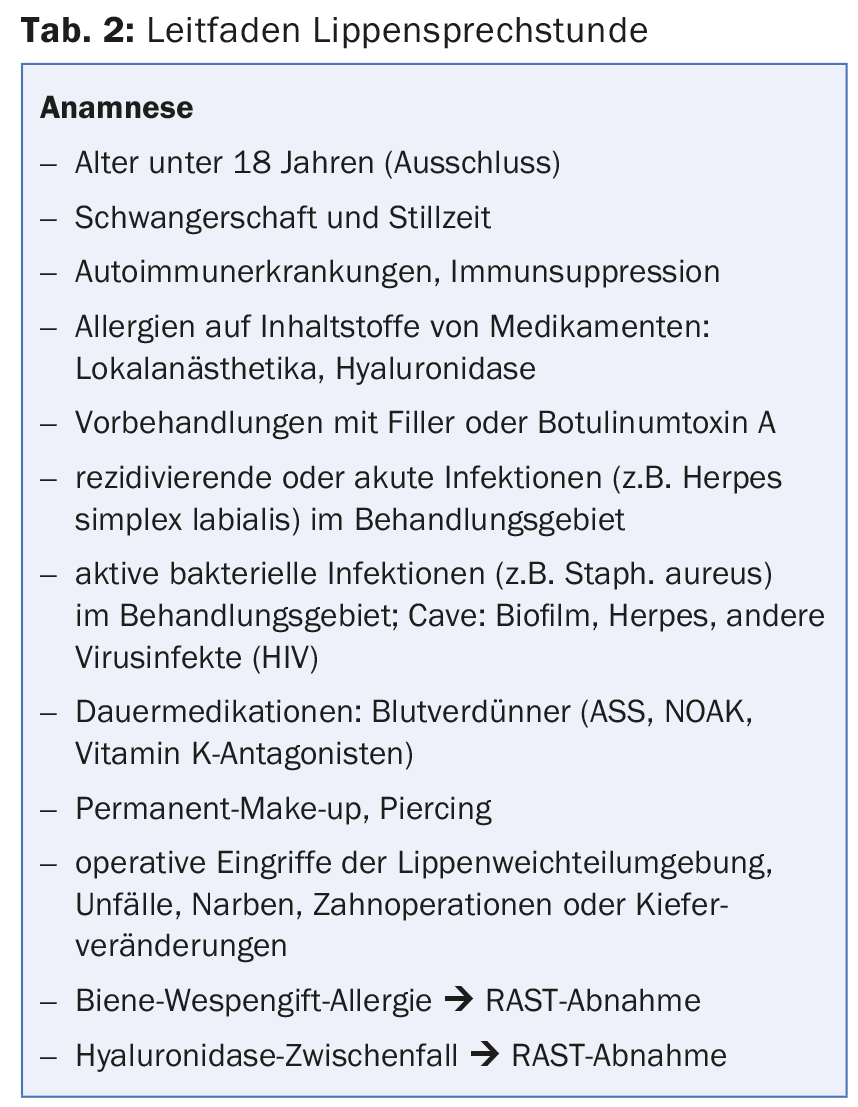
In the lip consultation, the first priority is education. Second most important is goal setting, which is done together with the patient. Often, patients’ ideas about lip enhancements differ from those of the practitioner. Here, an analysis and photo examples should guide patients so that both parties are satisfied. The number of sessions as well as the prices should be presented transparently. The individual HA products can also be discussed in more detail during the initial consultation – in varying degrees of detail depending on the patient’s thirst for information. More and more patients are well informed via the Internet and want more detailed information. Often there is a fear that the lip may look thick, asymmetrical or knotty after the therapy (fear of the “inflatable lip”, “ski jump upper lip” or “monkey upper lip”).
After the reconnaissance follows the joint planning. Patients bring a picture of themselves from the time when they found their lip and face shape the most beautiful – as well as a picture of their mother, so you have the information about genetics. Sometimes very little filler is needed in the lips. Even with volume augmentation of the cheeks alone (slight lifting of the corners of the mouth, marionette lines, and sagging cheeks) or just the chin area, it is often possible to enhance the profile view of the lip. Treaters should be able to communicate this well. If an unrealistic wish is put forward, ask whether this change would really suit the type.
A standardized photo documentation before and two weeks after the injection and also an injection protocol with drawing of the injection proposals should be made. Notes on the educational sheet about the content of the conversation and patient comments can be recorded. Any remaining questions about the treatment should be answered and noted before the first injection. Likewise, the course of further treatments or, for example, special events should be recorded.
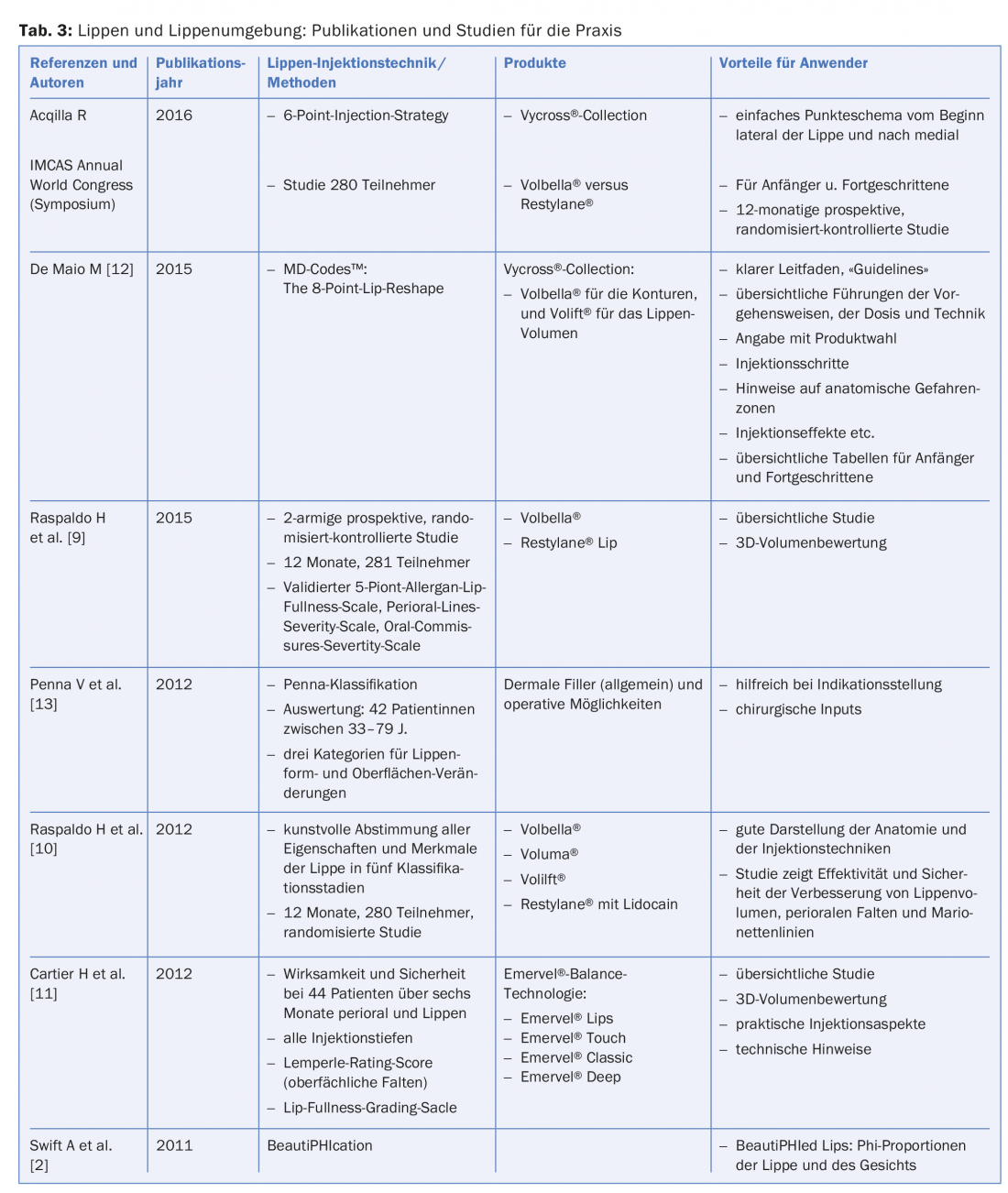
Finally, Table 3 provides an overview of interesting recent publications that are useful and can provide guidance when planning treatment of the lips and perioral region. It is also a small preview of the second part of the series, which will appear in the next DERMATOLOGIE PRAXIS and will take a closer look at the practice of filler treatment.
Conflict of interest: This work was supported by images and tables from Galderma, Allergan and Merz, beyond which there are no other conflicts of interest.
Acknowledgments: For providing the photographic material of the above mentioned companies and Dr. Mauricio de Maio, for support PD Dr. S. Cotofana, Dr. Thorsten Walker, Dr. Siegfried Schmidt,
Regine Raymond-Nachbauer and Marie Fritsche.
Literature:
- Becker-Wegerich PM: Interview: Rejuvenation of the lips. This way you create a harmonious result. The German Dermatologist 2015; 63(10): 6.
- Swift A, et al: BeautiPHIcation: A global approach to facial Beauty. Clin Plast Surg 2011; 38: 347-377.
- Segura S, et al. Complete Range of Hyaluronic Acid Filler With Distinctive Physical Properties Specifically Designed for Optimal Tissue Adaptations. J Drugs Dermatol 2012; 11(1 Suppl): s5-8.
- Tezel A, Frederrikson GH : The science of hyaluronic acid dermal filler. Journal of Cosmetic and Laser THERAPY 2008; 10: 35-42.
- Pierre S, Liew S, Bernardine A: Basics of Dermal Filler Rheology. Dermatologic Surgery 2015; 41(Suppl 1): S120-126.
- Ho D, Jadego J: Biologigcal properties of new volumizing hyaluronic acid fillers: a systematic review. Journal of Drugs in Dermatology (JDD) 2015; 14(1): 50-54.
- Taufig AZ, et al: New strategy for recording intradermal reactions after implantation of absorbable dermal fillers. J Aest Chir 2009; 2: 29-32.
- Edsman KL, et al: Is There a Method That Can Measure Cohesivity? Cohesion by Sensory Evaluation Compared With Other Test Methods. Dermatol Surg 2015; 41: S365-S372.
- Raspaldo H, et al: Juvéderm volbella with lidocaine for lip and perioral enhancement: A prospective, randomized, controlled trial. Plast Reconstr Surg Global Open 2015; 3(3): e321.
- Raspaldo H, et al: Lip and perioral enhancement: A 12- Month Prosective Randomized, Controlled Study. J Drugs Dematol 2015; 14(12): 1444-1452.
- Cartier H, et al: Perioral Rejuvenation With a Range of Customized Hyaluronic Acid Fillers: Efficacy and Safety Over Six Months With a Specific Focus on the Lips. Journal of Drugs in Dermatology 2012; 11(1 Suppl): s17-26.
- De Maio M: The 8-point-lip-reshape: Topographical anatomy. In: De Maio M: Unlocking the code to facial revitalization: A step-by-step approach to using injectables. Brazil 2015.
- Penna V, et al: Classification of the aging lips. Aesth Plast Surg 2015 Feb; 39(1): 1-7.
- Callan P, et al: Efficacy and safety of a hyaluronic acid filler in subjects treated for correction of midface volume deficiency: a 24 month study. Clinical, Cosmetic and Investigational Dermatology 2013; 6: 81-89.
- Hee CK, et al: Rheological Properties and In Vivo PerformanceCharacteristics of Soft Tissue Fillers. Dermatol Surg 2015; 41: S373-S381.
DERMATOLOGIE PRAXIS 2016; 26(3): 21-25

